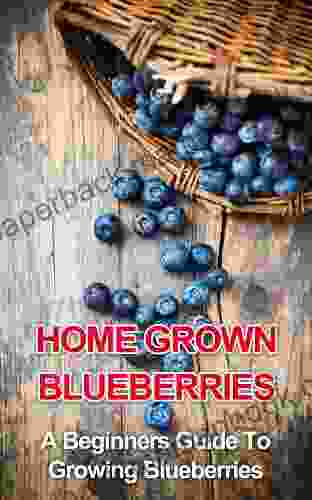A Beginner's Guide to Growing Blueberries: Homegrown Berries Made Easy

4.2 out of 5
| Language | : | English |
| File size | : | 922 KB |
| Text-to-Speech | : | Enabled |
| Screen Reader | : | Supported |
| Enhanced typesetting | : | Enabled |
| Print length | : | 19 pages |
| Lending | : | Enabled |
Growing blueberries at home is a rewarding and enjoyable experience that can provide you with an abundance of fresh, delicious berries right in your own backyard. Whether you're a seasoned gardener or just starting out, this comprehensive guide will provide you with the knowledge and techniques you need to cultivate thriving blueberry plants and reap the benefits of homegrown berries.
Soil Requirements
Blueberries are acid-loving plants that prefer well-drained, acidic soil with a pH range of 4.5 to 5.5. If your soil is not naturally acidic, you can amend it with sulfur or peat moss to lower the pH. It's important to test your soil before planting to determine the pH level and make any necessary adjustments.
Plant Selection
There are many different varieties of blueberries available, each with its own unique flavor, ripening time, and growing habits. When selecting blueberry plants for your garden, consider the following factors:
- Hardiness zone: Blueberries can grow in USDA hardiness zones 3 to 9. Choose a variety that is suitable for your climate.
- Size: Blueberry plants come in a range of sizes, from dwarf varieties that grow to 2 feet tall to standard varieties that can reach heights of 6 feet or more. Choose a size that is appropriate for your garden space.
- Ripening time: Blueberry varieties ripen at different times throughout the summer. Select a combination of early, mid-season, and late-season varieties to extend your harvest.
- Flavor: Blueberries come in a range of flavors, from sweet to tart. Taste different varieties before choosing the ones you want to grow in your garden.
Planting
Blueberries should be planted in the spring or fall when the weather is cool. Dig a hole that is twice as wide as the root ball of the plant and just as deep. Place the plant in the hole and backfill with soil, tamping down gently to remove any air pockets. Water the plant thoroughly after planting.
Space blueberry plants 3 to 5 feet apart to allow for proper air circulation and fruit production.
Pruning
Pruning is an important part of blueberry care. It helps to keep the plants healthy and productive. Prune blueberry plants in the late winter or early spring before new growth begins.
To prune blueberry plants, follow these steps:
- Remove suckers: Suckers are shoots that grow from the base of the plant. These shoots will not produce fruit, so they should be removed to prevent them from diverting energy away from the main plant.
- Prune dead or diseased branches: Cut off any branches that are dead, diseased, or broken.
- Thin out branches: Remove any branches that are crossing or rubbing against each other. This will help to improve air circulation and reduce the risk of disease.
- Head back canes: Cut back the tips of the canes by 1/3 to 1/2. This will encourage the plant to produce more fruit.
Fertilizing
Blueberries require regular fertilization to produce healthy plants and fruit. Fertilize blueberry plants in the spring and again in the fall. Use a fertilizer that is specifically formulated for blueberries and follow the instructions on the package.
Watering
Blueberries need regular watering, especially during hot, dry weather. Water the plants deeply and regularly, allowing the soil to dry out slightly between waterings. Avoid overwatering, as this can lead to root rot.
Mulching
Mulching around blueberry plants helps to retain moisture, suppress weeds, and regulate soil temperature. Use a mulch that is made from organic materials, such as wood chips, pine needles, or compost. Spread the mulch around the plants in a 2- to 3-inch layer.
Pest and Disease Control
Blueberries are relatively pest- and disease-resistant, but they can be affected by a few common problems. Here are some tips for controlling pests and diseases in blueberry plants:
- Birds: Birds love to eat blueberries, so it's important to protect your plants from them. You can use netting or scare tactics to keep birds away.
- Aphids: Aphids are small, green insects that suck the sap from blueberry plants. To control aphids, use insecticidal soap or neem oil.
- Blueberry maggots: Blueberry maggots are flies that lay their eggs in blueberry fruits. The larvae of these flies feed on the fruit, causing it to rot. To control blueberry maggots, use traps or insecticides.
- Mummy berry: Mummy berry is a fungal disease that affects blueberry plants. The fungus causes the berries to shrivel and turn brown. To control mummy berry, remove and destroy infected berries and improve air circulation around the plants.
Harvesting
Blueberries are ready to harvest when they are fully ripe and have turned a deep blue color. To harvest blueberries, gently pick the berries from the stems. Avoid pulling the berries, as this can damage the plants.
Blueberries can be eaten fresh, frozen, or used in jams, jellies, and other recipes. Enjoy the fruits of your labor and savor the sweet taste of homegrown blueberries!
Growing blueberries at home is a rewarding and enjoyable experience that can provide you with fresh, delicious berries for years to come. By following the tips in this guide, you can successfully cultivate thriving blueberry plants and reap the benefits of homegrown berries.
So what are you waiting for? Get started today and experience the joy of homegrown blueberries!

4.2 out of 5
| Language | : | English |
| File size | : | 922 KB |
| Text-to-Speech | : | Enabled |
| Screen Reader | : | Supported |
| Enhanced typesetting | : | Enabled |
| Print length | : | 19 pages |
| Lending | : | Enabled |
Do you want to contribute by writing guest posts on this blog?
Please contact us and send us a resume of previous articles that you have written.
 Top Book
Top Book Novel
Novel Fiction
Fiction Nonfiction
Nonfiction Literature
Literature Paperback
Paperback Hardcover
Hardcover E-book
E-book Audiobook
Audiobook Bestseller
Bestseller Classic
Classic Mystery
Mystery Thriller
Thriller Romance
Romance Fantasy
Fantasy Science Fiction
Science Fiction Biography
Biography Memoir
Memoir Autobiography
Autobiography Poetry
Poetry Drama
Drama Historical Fiction
Historical Fiction Self-help
Self-help Young Adult
Young Adult Childrens Books
Childrens Books Graphic Novel
Graphic Novel Anthology
Anthology Series
Series Encyclopedia
Encyclopedia Reference
Reference Guidebook
Guidebook Textbook
Textbook Workbook
Workbook Journal
Journal Diary
Diary Manuscript
Manuscript Folio
Folio Pulp Fiction
Pulp Fiction Short Stories
Short Stories Fairy Tales
Fairy Tales Fables
Fables Mythology
Mythology Philosophy
Philosophy Religion
Religion Spirituality
Spirituality Essays
Essays Critique
Critique Commentary
Commentary Glossary
Glossary Bibliography
Bibliography Index
Index Table of Contents
Table of Contents Preface
Preface Introduction
Introduction Foreword
Foreword Afterword
Afterword Appendices
Appendices Annotations
Annotations Footnotes
Footnotes Epilogue
Epilogue Prologue
Prologue M V Kasi
M V Kasi Lillian Day
Lillian Day Kindle Edition
Kindle Edition Robert Vitelli
Robert Vitelli Cindy Watson
Cindy Watson Jackie Newgent
Jackie Newgent Dana Thomas
Dana Thomas Kat Savage
Kat Savage Chanelle Arterbridge
Chanelle Arterbridge Louis Becke
Louis Becke Michael Robins
Michael Robins Wes Bush
Wes Bush Olive Schreiner
Olive Schreiner Buzz Campion
Buzz Campion Kristof Gustavson
Kristof Gustavson Renee Patterson
Renee Patterson Tom Spence
Tom Spence Mark Anielski
Mark Anielski Mark Simmons
Mark Simmons Sherpaherb
Sherpaherb
Light bulbAdvertise smarter! Our strategic ad space ensures maximum exposure. Reserve your spot today!

 Cameron ReedAn Anthology of Persian Short Fiction: A Journey into the Heart of Iranian...
Cameron ReedAn Anthology of Persian Short Fiction: A Journey into the Heart of Iranian... Glenn HayesFollow ·2.5k
Glenn HayesFollow ·2.5k Houston PowellFollow ·16.1k
Houston PowellFollow ·16.1k Colin RichardsonFollow ·19k
Colin RichardsonFollow ·19k Christian CarterFollow ·18.7k
Christian CarterFollow ·18.7k Gene SimmonsFollow ·5.4k
Gene SimmonsFollow ·5.4k Damon HayesFollow ·3.7k
Damon HayesFollow ·3.7k Floyd PowellFollow ·15.4k
Floyd PowellFollow ·15.4k Dakota PowellFollow ·12.2k
Dakota PowellFollow ·12.2k

 Jeremy Mitchell
Jeremy MitchellPlay We Now On Christmas Violin Christmas: A Heartfelt...
Play We Now On...

 Terry Bell
Terry BellTales from the Road: Confessions of an Atlanta Uber...
In the vibrant...

 Ervin Bell
Ervin BellThe French Admiral: A Gripping Naval Adventure with Alan...
In the vast expanse of...

 Henry David Thoreau
Henry David ThoreauCrochet Cozy Afghan Patterns: Crochet Weekend Afghan...
to Crochet...

 Orson Scott Card
Orson Scott CardAn Archaeological View Of The Industrialization Of North...
The industrialization of North America was a...

 Josh Carter
Josh CarterClipboard Christmas Skits by Tom Spence: A Festive...
A Christmas...
4.2 out of 5
| Language | : | English |
| File size | : | 922 KB |
| Text-to-Speech | : | Enabled |
| Screen Reader | : | Supported |
| Enhanced typesetting | : | Enabled |
| Print length | : | 19 pages |
| Lending | : | Enabled |










